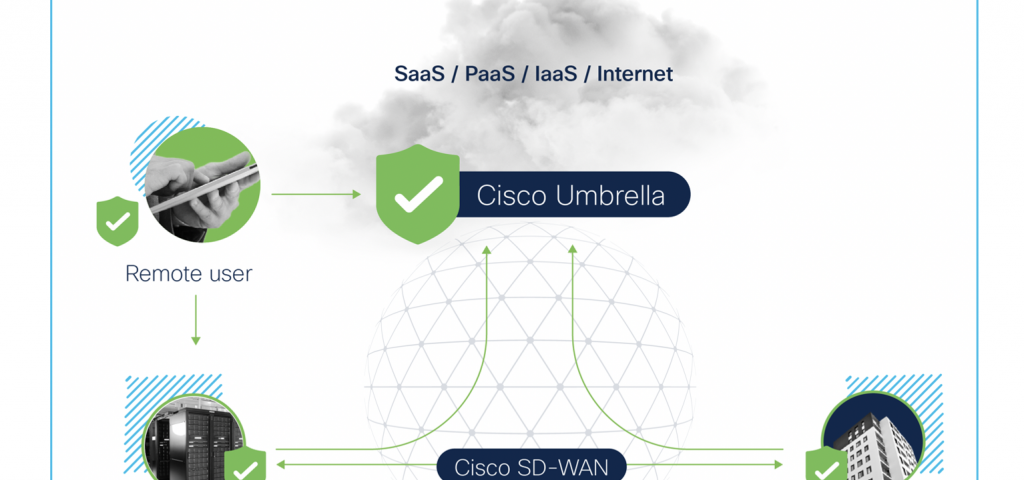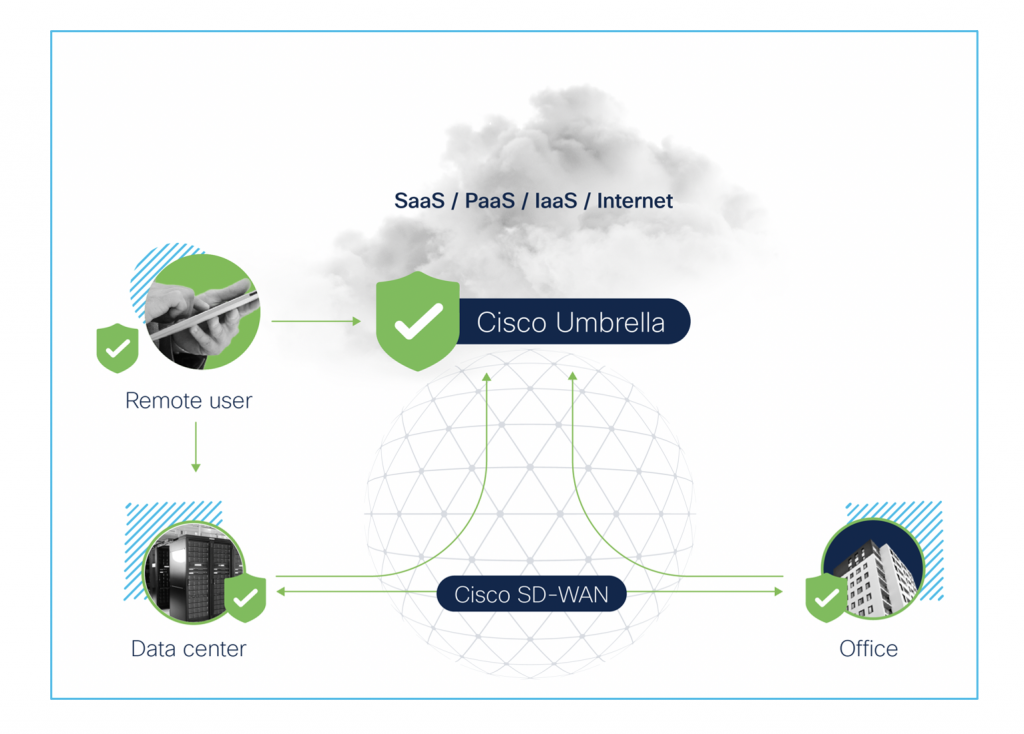Cisco Secure – Conquering Complexity with Simplified Security
October 28, 2020Strengthen customer relationships with Cisco SecureX
October 28, 2020Cisco Takes a Simple, Secure, and Scalable Approach to SASE

The erosion of the network perimeter has accelerated over the last year and this has changed the way we look at security. I wrote a blog about the emerging concept of a Secure Access Service Edge (SASE) architecture earlier this year and highlighted the core components that are required. In the past few months I haven’t seen anyone debunk the SASE direction that Gartner outlined, but I have seen many different interpretations of the approach and evaluation criteria that should be used when developing a SASE strategy.
I think it would be best to reference the challenges that fueled the development of this concept, to help ground us on the proper areas of focus or evaluation.
- Increased security and networking complexity in distributed environments
- Gaps in security and performance problems related to cloud/SaaS adoption
- Scale and throughput across a wide range of security functions
The SASE concept is based on cloud-native capabilities that simplify the IT environment while improving security and enabling dynamic scalability (simplicity, security, and scalability). We believe that these are the core tenants that you should keep in mind as you develop your SASE strategy. Based on that structure, let’s take a look at how Cisco is delivering on the SASE vision.
Simplification
Cisco’s Umbrella, Duo and Meraki solutions have consistently delivered high performance while leading the market with their simplified customer experience from initial deployment to configuration and ongoing management tasks. For example, in the last eighteen months Umbrella has added secure web gateway, firewall as-a-service and CASB capabilities all within its single, easy to use console. I recently blogged about the addition of the SecureX to all Cisco security solutions. This security platform not only aggregates data from across the Cisco security portfolio it also includes third-party data and automated response actions to further simplify the daily tasks of your security analysts and improve response time.
One of the leading SASE use cases involves the transition to direct-internet-access (DIA) from branches and remote offices. To date early adopters have struggled with long deployment times because of the complex SD-WAN, tunnel and cloud security integration tasks. Cisco has drastically simplified the solution to this multi-faceted challenge starting from purchasing (with a single Cisco SD-WAN and Umbrella SKU), through deployment (with automated integration of Cisco SD-WAN and Umbrella) so you can get hundreds of locations connected quickly, to simplified, ongoing management (policy control from one cloud-based dashboard and automated failover).
Another popular SASE use case involves connecting and protecting remote/home based workers. Cisco has simplified the process for remote workers to connect into Umbrella cloud security from a variety of devices no matter where they are. The AnyConnect client (which is included with Umbrella SIG Essentials package) has recently grown to cover over 100 million devices and can easily direct outgoing traffic to Umbrella for a broad set of security functions.

Security
Gartner currently shows the SASE concept rising quickly on the hype cycle. Many vendors are claiming flashy, SASE-like capabilities, but when evaluating solutions, it’s important to keep the end goal in mind. What good is it to carry traffic and have flashy dashboards if you aren’t effective stopping the increasing amount of internet-based threats that are bogging down Security teams and costing millions of dollars to remediate?
At Cisco we pride ourselves on our security effectiveness. Cisco Advanced Malware Protection (AMP) posted the highest score for malware detection in recent, independent testing and was in the lowest group for false positives. Umbrella has placed number one for multiple years on third party tests for detection of new malware, malicious files and phishing attacks. AV-TEST just placed Cisco Umbrella first in security efficacy (see the Raviv Levi blog), after Umbrella received the highest security detection rate (96.39%) in the recent AV-TEST report. Umbrella unifies DNS-layer protection, secure web gateway, advanced threat detection, firewall, and cloud access security broker (CASB) functionality, making security invisible and seamless to the end user, regardless of what device they are using. In the same set of tests, Umbrella also received the number one position for having the lowest percentage of false positives (0.65%) across all vendors tested. The best threat detection and blocking with the least amount of time-consuming false incidents is the best of both worlds for overworked security teams.
Scalability
As cloud adoption accelerates your internet traffic multiplies quickly. Luckily Cisco has a lot of experience building high performance, high volume networks. Umbrella is built on a resilient, global cloud infrastructure that boasts 100% business uptime since 2006. Umbrella provides direct peering with over 1000 of the world’s top internet service providers (ISPs), content delivery networks (CDNs) and SaaS platforms to deliver the fastest route for any request — resulting in superior speed, effective security and the best user satisfaction. Recent Miercom testing of typical SaaS traffic showed that Umbrella’s network delivers up to a 7X reduction in latency when compared to a typical ISP connection.
The Umbrella network currently handles over 250 billion internet requests per day. Using Anycast routing, our customer facing data centers across the globe are available using the same single IP address. As a result, your requests are transparently sent to the nearest data center and failover is automatic. Our infrastructure is built in an elastic format which provides extreme flexibility enabling traffic to scale up dramatically, delivering a low latency path to their applications no matter where they are hosted. Unlike many other providers, Cisco doesn’t just rent common infrastructure from a public cloud service. We own, actively manage and tune our own equipment for high throughput security. This empowers us to adjust the control necessary to maintain consistent high performance.
Start the journey now and do SASE your way
Implementing a full SASE architecture is a multi-step journey that will be different for each organization, but the time to start is now. At Cisco, we have a proven track record in the core SASE areas of networking, security, and identity services. We can provide you with solutions that include the consolidation, ease of deployment, and management that you need to scale your business, and provide effective security for users anywhere they choose to work – without a degradation in speed, performance or user experience. And we know it’s important for you to be able to choose a transition path that works best for your business, and support integration with your existing security investments. So, let’s go…pick a partner you trust, it’s time to get SASE!
For more information see the Roadmap to SASE or visit the SASE webpage.
The post Cisco Takes a Simple, Secure, and Scalable Approach to SASE appeared first on Cisco Blogs.

